Dropshipping Profit Margin: A Step-By-Step Guide For Beginners
Are you considering starting a dropshipping business but unsure how to calculate your dropshipping profit margin? It’s important to understand the financial aspect of dropshipping to ensure a successful and profitable venture.
Moreover, as a dropshipping store owner, your dropshipping product pricing strategy is another cornerstone decision you will have to make. It affects almost every aspect of your business.
Therefore, it is a deciding factor in your core business: from your dropshipping profit margin to your cash flow.
Now, you are probably asking yourself, “What is a good profit margin for dropshipping?”, “How do I calculate my dropshipping profit margins?”, “How should I price my products?”, and “What type of dropshipping product pricing strategy should I use to increase my profit margins?”
If these are your questions, you are definitely in the right place! I have all the necessary dropshipping profit margin info for you in one place!
So, let’s dive in.


Table of Contents
- What Is A Good Dropshipping Profit Margin?
- Most Important Profit Margin Stats For Your Dropshipping Store
- Why Is Analyzing Your Dropshipping Profit Margin Important?
- The No. 1 Tool for all dropshippers – now with AI
- What Is The Average Dropshipping Profit Margin?
- How To Calculate Your Profit Margins For Dropshipping?
- Dropshipping Product Pricing: How To Price Your Products
- Dropshipping Product Pricing Strategies
- How To Select The Most Profitable Products to Sell Online?
- High Margin Dropshipping Products
- How Much Does The Average Dropshipper Make?
- Calculate Shopify Gross Margin
- FAQs – Dropshipping Profit Margins
- 1. What is a good profit margin on dropshipping?
- 2. How much profit can you make from dropshipping?
- 3. Is a 6% profit margin good?
- 4. Is 30% profit margin too high?
- 5. Is 13% profit margin good?
- 6. Is a 50% profit margin too much?
- 7. What profit margin is good with Shopify?
- 8. What is a good dropshipping profit margin in 2024?
- Your Dropshipping Profit Margin matters
What Is A Good Dropshipping Profit Margin?
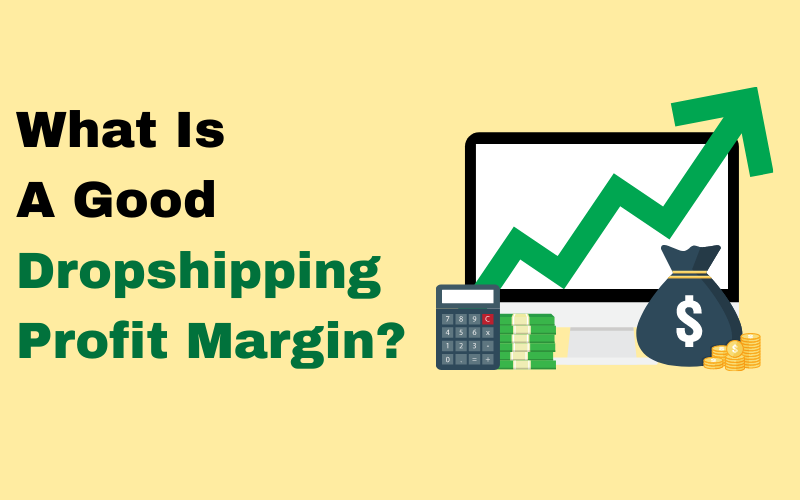
With the dropshipping business model, you buy a product from a dropshipping supplier at a certain price. To earn a profit, you sell that product for more than what you paid.
Simply put, a profit margin represents what percentage of sales has turned into profits. It is actually a ratio calculation that suggests how much out of your overall sales your business keeps.
In general, a good profit margin for dropshipping is anything over 20%. But, it can vary based on what types of goods you are selling and where you are selling them.
So, before I add products to my dropshipping store, what I always do is check on the supplier price for the specific product vs the market price. This way, I get a sense of the profit I may earn. For example, let’s say I want to sell this women’s bag.👇
And, I want to earn a profit margin of 30%, you can use the following formula:
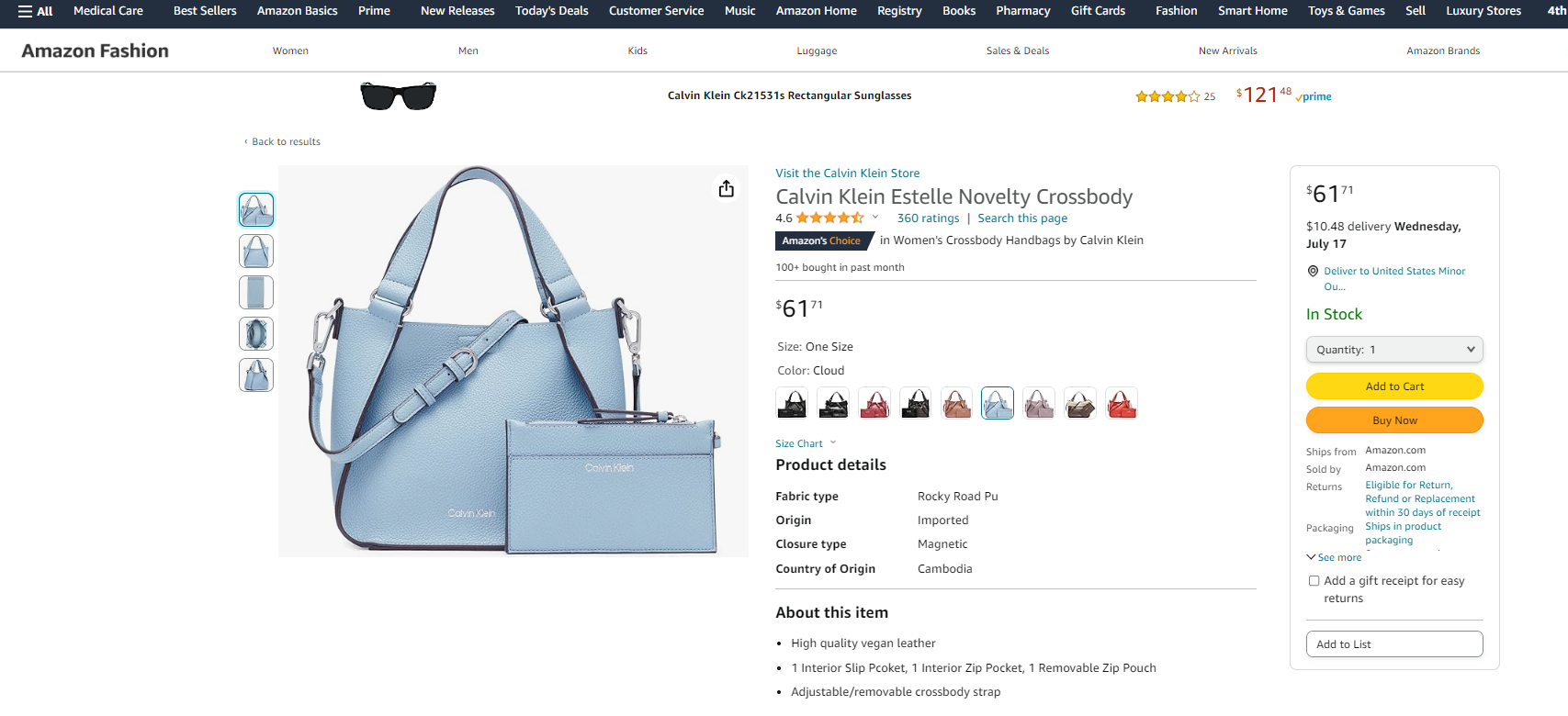
Selling Price = Cost Price + (Cost Price * Profit Margin)
First, calculate the profit margin amount:
Profit Margin Amount = $61 * 0.30 = $18.30
Next, add the profit margin amount to the cost price to get the selling price:
Selling Price = $61 + $18.30 = $79.30
So, if you sell the women’s bag at $79.30, your profit will be $18.30. Here’s how the scenario looks:
You purchase a women’s bag for $61. By adding a 30% profit margin, you set the selling price at $79.30. When the bag sells, you earn a profit of $18.30. This approach ensures you cover your costs while making a reasonable profit.
However, let’s learn how you can calculate your dropshipping profit marginsn detail!
👉 Check out the Best 8 Profitable Niches With Low Competition For Dropshippers.
👉 Check out the Top 11 Richest Dropshipping Store Owners In The World.
Most Important Profit Margin Stats For Your Dropshipping Store
You can run a successful dropshipping business, but you should be aware of the importance of profit margins. Thus, it’s a good idea to start by informing yourself better about dropshipping profit margin stats.
💡Tip: Learn How To Make 5k a Month With A Real Business.
This article will discuss the most important dropship profit margins for you. Let’s get started!
🔸 Cost of Goods Sold (COGS)

The cost of goods sold (COGS) is an important factor in determining your gross dropshipping profit margin. As a result, it is a critical dropshipping stats!
The direct expenses of manufacturing the products sold by a business are referred to as the Cost Of Goods Sold (COGS).
These dropshipping stats cover the cost of the materials and labor necessary to make the product.
Thus, when dropshipping, the price you pay to your dropshipping supplier is the same as the COGS.
Let’s assume that you sold 100 items in the previous month and paid your dropshipping supplier $7 for each unit. Therefore, your COGS would be $700 in that situation. Clear enough?
The Cost Of Goods Sold ( COGS) is calculated using the following formula:
(Beginning Inventory + Cost of Goods) – Ending Inventory = Cost of Goods Sold
Furthermore, COGS does not include secondary expenses like distribution and sales force costs.
🔸 Average order value (AOV)
The average order value (AOV) measures the average dollar amount spent on your dropshipping store every time a consumer places an order.
So, how to calculate AOV? Simply divide total revenue by the number of orders to determine your company’s average order value.
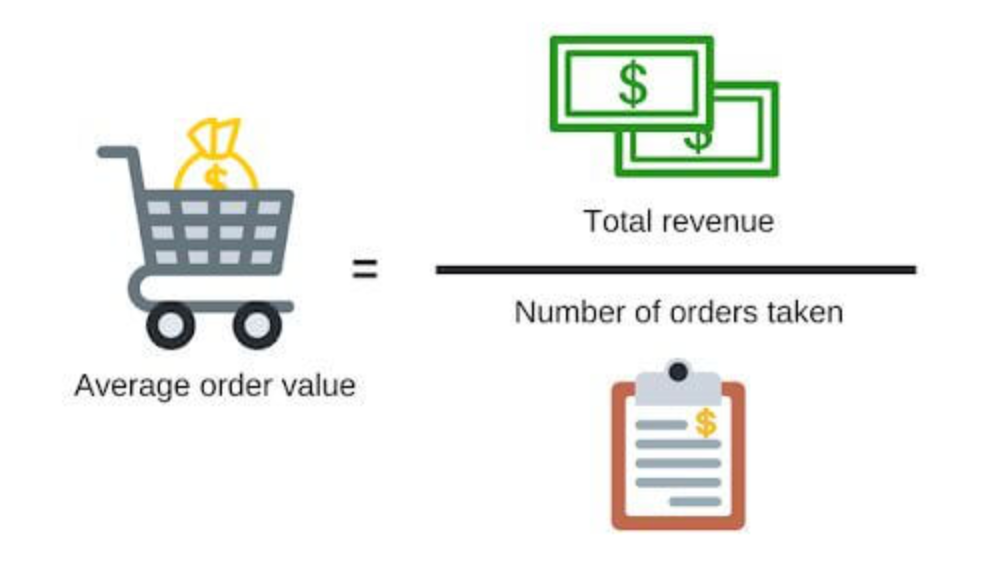
For example, let’s suppose that your dropshipping business made $10,000 in sales in September and received 1,000 orders. $10,000 divided by 1,000 is $10, therefore the monthly AOV for September was $10.
Furthermore, AOV is a crucial performance dropshipping stat that dropshippers use to better understand their consumers’ purchasing behavior.
The AOV, like other critical indicators, may be measured over any time period. Moreover, increasing your AOV will boost your dropshipping profit margin.
🔸 Customer lifetime value (CLV)
Customer lifetime value (CLV) is a measure of how much money a company can expect to make from a customer for as much as this person stays a customer.
Thus, the CLV is calculated as follows:

CLV = AOV * Number of transactions per month * Retention period
So, let’s say that over a 5-year customer engagement, a specific consumer pays $40 every visit to your dropshipping store, and he/she visits once every two weeks (this means 26 times a year). By multiplying all three values together — 40 x 26 x 5 — you get 5200 CLV. But, why do you need this statistic?
- Improve Consumer Retention. Tracking these characteristics with precise segmentation can assist you in identifying your top clients and determining what works successfully.
- Encourage Repeat Purchases. CLV may be used to measure the average number of visits per year or during the lifetime of a customer and apply that data to design strategies to boost repeat business.
- Promote Higher-Value Sales. Cost increases that are too rapid may turn off long-term clients. The appropriate balance is essential for success here.
- Increase Your Profit. Overall, a larger CLV should result in greater profits. You should notice a boost if you retain consumers longer and establish a business that encourages them to spend more.
👉 Read more: The importance of Data in Dropshipping.
Furthermore, when calculating CLV, consider the total average total profits made by a consumer, but also consider the total average profit.
Each of them gives valuable information about how consumers engage with your company and if your entire marketing strategy is operating as planned.
🔸 Conversion rate
The conversion rate is the percentage of visitors to your dropshipping shop that make a purchase.
Calculating the conversion rate is quite easy, all you need to do is divide the number of orders by the number of unique visitors.

Conversion rate = Number of orders / Number of unique visitors
So, let’s assume that you had 60 orders and 2,000 unique visits in September. Following the formula, divide 60 by 2,000 and you will get 0.03. In other words, 3% of your dropshipping store visitors purchased something.
💡 Tip: keep in mind that conversion rates vary by niche and product type.
Conversion rates are a good approach to comparing and evaluating the performance of different advertising channels.
As in the previous example, conversion rates are very important when running mobile user acquisition campaigns since they allow you to track the effectiveness of each campaign.
👉 Learn some effective ways how to double the conversion rate to your dropshipping store.
🔸 Customer acquisition cost (CAC)
Client acquisition cost (CAC) is the amount of money spent by a business to attract a new customer.
These dropshipping stats is determined by summing the costs of converting prospects into customers (marketing, advertising, sales employees, and other expenses) and dividing the amount by the number of customers obtained.
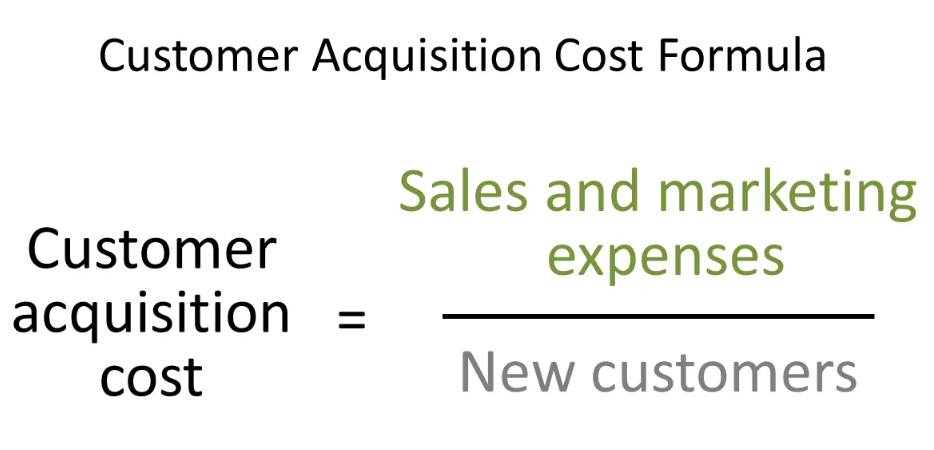
CAC = Total marketing costs/number of new customers
Let’s assume that you spent $2,000 on marketing in September and obtained 40 new clients. Therefore, your CAC will be $2,000/40, which equals $50.
Moreover, CAC assists you in calculating the return on investment of attempts to expand your customer base.
👉 Check out How Much Does It Cost To Start Dropshipping In 2024?
🔸 Shipping costs
For a dropshipping business, shipping costs are a very important one! These costs affect your profits, and can seriously lower them. They include the costs of shipping labels, packing, and post.
You may calculate your dropshipping store shipping expenses by looking at how much you paid to your supplier for shipping for all orders dispatched in a certain time period.
💡 Tip: Read about Dropshipping Taxes and Payments – Must-Know Facts.
🔸 Refund rate
The refund rate refers to the percentage of returned orders.
If you want to calculate these dropshipping stats, just divide the number of refunds by the total number of orders.
Refund rate = Number of refunds / Total number of orders
Why Is Analyzing Your Dropshipping Profit Margin Important?
If you want to be successful in the long run in this dropshipping world, analyzing your dropshipping profit margins is very important!
If you don’t know your dropshipping profit margin, you won’t be able to determine which goods are profitable and which are not.
For instance, I always find helpful apps like Adserea, where I search for my winning products, and their insights, like cost price, sales price, profit margins, number of suppliers, competition analysis, and more.
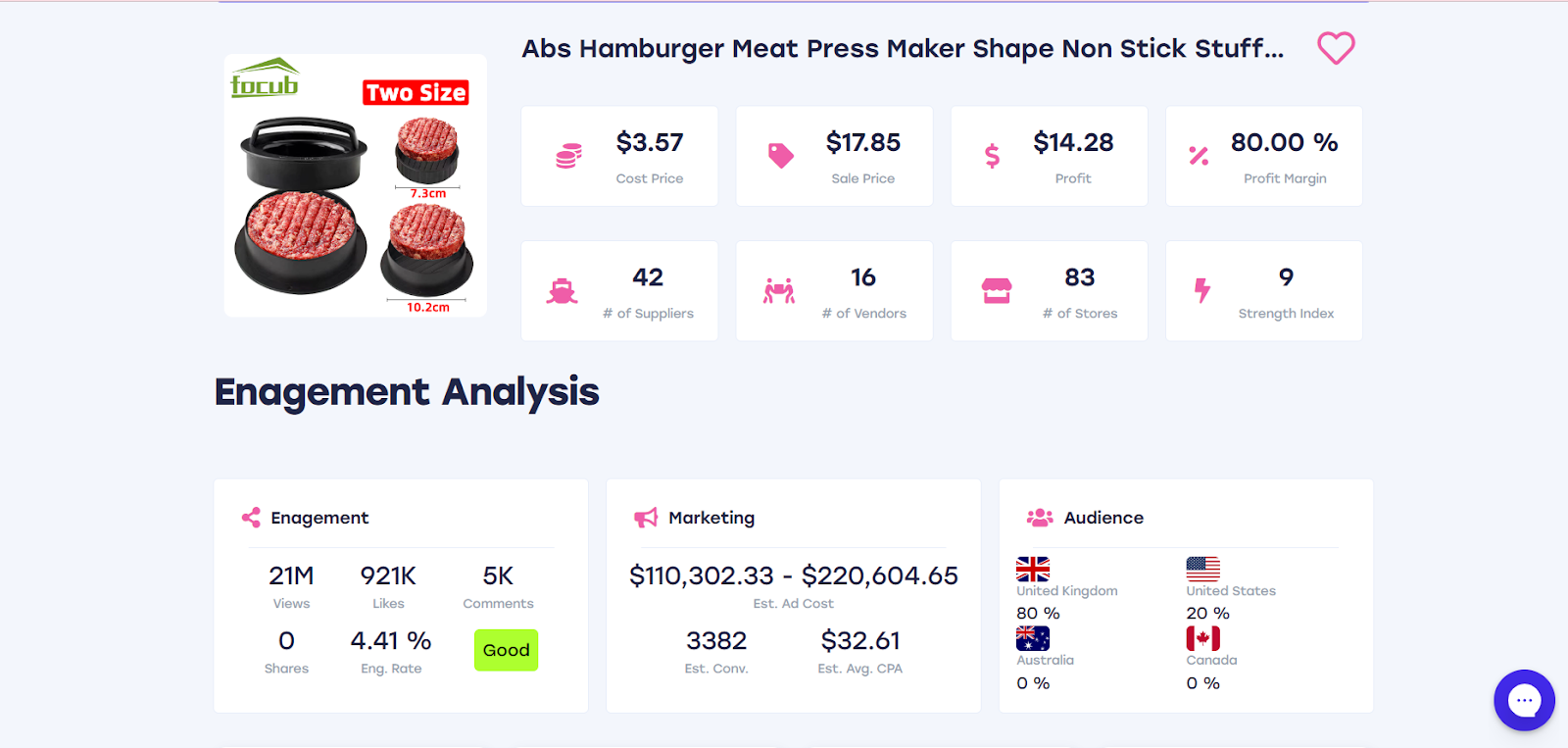
👉 Check out my FULL Adserea Review: Best Dropshipping Product Spy Software?
As a result, if you don’t analyze the dropshipping profit margins, you may find yourself dropshipping a lot of things that make you no money!
Moreover, analyzing your dropshipping profit margins will help you to better understand your dropshipping business and make good decisions on where and how to invest your money and allocate resources.
Furthermore, this valuable statistic will help you find more profitable items to dropship instead of less profitable ones, and it will also assist you in pricing your products effectively.
What’s more, it also allows you to track your performance and see whether you are progressing over time.
So, once we learned why analyzing dropshipping profit margins is important, let’s learn more about all the how-tos: increasing profit margins and calculating them!
What Is The Average Dropshipping Profit Margin?
The average dropshipping profit margin is between 15%-20%. As mentioned earlier, your dropshipping profit margin depends on the types of goods you are selling and where you are selling them.
But regardless of that, you must keep your pricing competitive while ensuring your product markups are adequate in order to make a good profit.
Make sure you have our ultimate dropshipping checklist before starting a dropshipping store in front of you. To avoid any challenges during the journey, also have this business starting checklist on your side.
And, if you are asking yourself, “What profit margin should I aim for?”, the average dropshipping profit margin might be your smartest shot!
How To Calculate Your Profit Margins For Dropshipping?
The good news is that there is a simple profit margin formula that you can put into practice. And here is the formula to calculate your dropshipping profit margin:
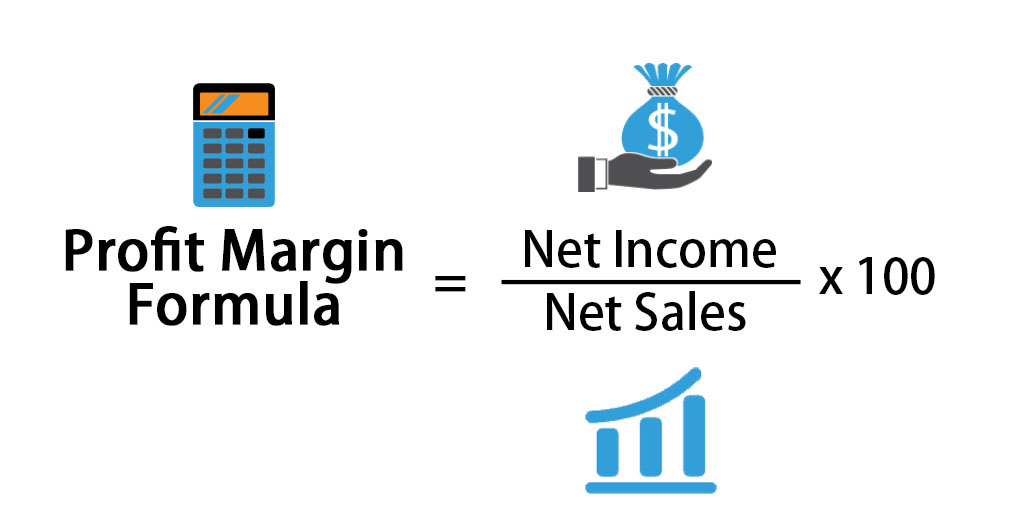
{(Sales Price – Costs) / Sales Price} x 100 = Profit Margin
Let’s assume that you have a dropshipping business for electronics and made $1 million in sales last year.
Then, you need to subtract all of your expenses and costs, including the cost of your products, shipping, marketing, fees, etc., from your sales price. Let’s say that all of your expenses and costs stand at $700,000. In that case, you are left with net profits of $300,000.
To calculate your dropshipping profit margin, just divide your net profits by your sales price and multiply that number by 100.
Now, I will show you the steps to help you learn how to simplify the formula on your own.
{($1,000,000 – $700,000) / $1,000,000} x 100 = 30%
- Sales price = $1,000,000
- Costs = $700,000
- Net profits = $300,000
- Profit margin = 30%
Just follow these steps:
- Subtract costs from sales price: $1,000,000 – $700,000 = $300,000
- Divide net profits by sales price: $300,000 / $1,000,000 = 0.3
- Express it in percentages, i.e., multiply it by 100: 0.3 x 100 = 30%
According to this formula, your profit margin is 30%.
But keep in mind that it is essential to calculate margins for every single item you list for sale. Of course, the calculation process is the same.
Now that you know how to calculate your dropshipping profit margin, let’s move on to the next topic: Dropshipping product pricing.
Dropshipping Product Pricing: How To Price Your Products
Have you ever been in the retail industry, found a popular item, and promoted it, only to end up with no sales?
Unquestionably, it is an extremely unpleasant feeling, which can make you second guess yourself. “Did I choose the wrong product?” “Why is my marketing strategy ineffective?”
The truth is, there are many factors that can have a negative effect on your dropshipping business’ financial success.
Luckily, one of those factors is easy to fix. And all you need to do is to price your products correctly. In fact, a great product does not guarantee success. Not only should you have a great product to sell, but you should also price that product correctly.
Specifically, if you set your prices too low, it will lead to lower margins, causing you to miss out on potential profit and revenue. And if you set your prices too high, it will cause you to miss out on a lot of sales.
But pricing your products correctly is not all about covering the expenses and having an adequate dropshipping profit margin.
It is much more than that. It is actually a complex process that involves a few steps. Just do not rush and take it one step at a time!
And here is how to do so. 👇
1. Know what your business expenses are and define your minimum retail price
To get started, you need to calculate a base retail price for every single item you are about to sell. However, that price needs to cover all of your expenses.
The most common expenses you will need to cover include:
- Wholesale product costs
- Shipping costs
- Website fees (e.g., logo design, store theme, etc.)
- Recurring monthly/annual fees (e.g., e-commerce platforms like Shopify, Shopify dropshipping apps, etc.)
- Marketing/advertising costs
💡 Tip: Learn about Shopify Pricing Plans: What’s The Cost Of Dropshipping With Shopify?
Needless to say, you also need to take into account any unexpected costs. Therefore, it is advisable to increase your total expense number by an extra 10%.
Moreover, when defining the minimum retail price for any item, make sure you do not lose money on your items. This can give you a good start, enabling you to avoid risking profitability and understand how low you can possibly go.
Find out what the risks of dropshipping are and ways to avoid big losses.
Try to include and calculate all those information while creating your dropshipping business plan.
2. Understand your target market
As you can see, not everything revolves around covering the costs and expenses. To set the right prices for your products, you must have an understanding of your target market.
But what does this mean? This means that you must be familiar with product availability and seasonality.
➡ Product availability
Product availability is, without a doubt, a major factor in deciding how much to charge for an item.
On the one hand, certain dropshipping products with high-profit margins aren’t widely available. So, if you choose to sell these products, there may be a higher demand for them, and you may increase your price.
On the other hand, certain products, such as phone cases, are quite common. As a result, they usually require a lower price point to be competitive. Having an idea of how much you can charge for a product while still encouraging sales is crucial.
➡ Product demand and seasonality
Another important factor you need to consider when pricing your dropshipping products is product demand and seasonality.
In short, different items sell better during different seasons. For example, the demand for swimsuits is much higher during the spring and summer, whereas the demand for wool coats is higher during the winter.
Being aware of the impact of demand and seasonality on sales allows you to adjust pricing to maximize profits all year round.
So, what I do here is use Google Trends specialty. Hence, I type in a certain product keyword and get my information. For example, let’s say I want to sell a swimsuit. 👇
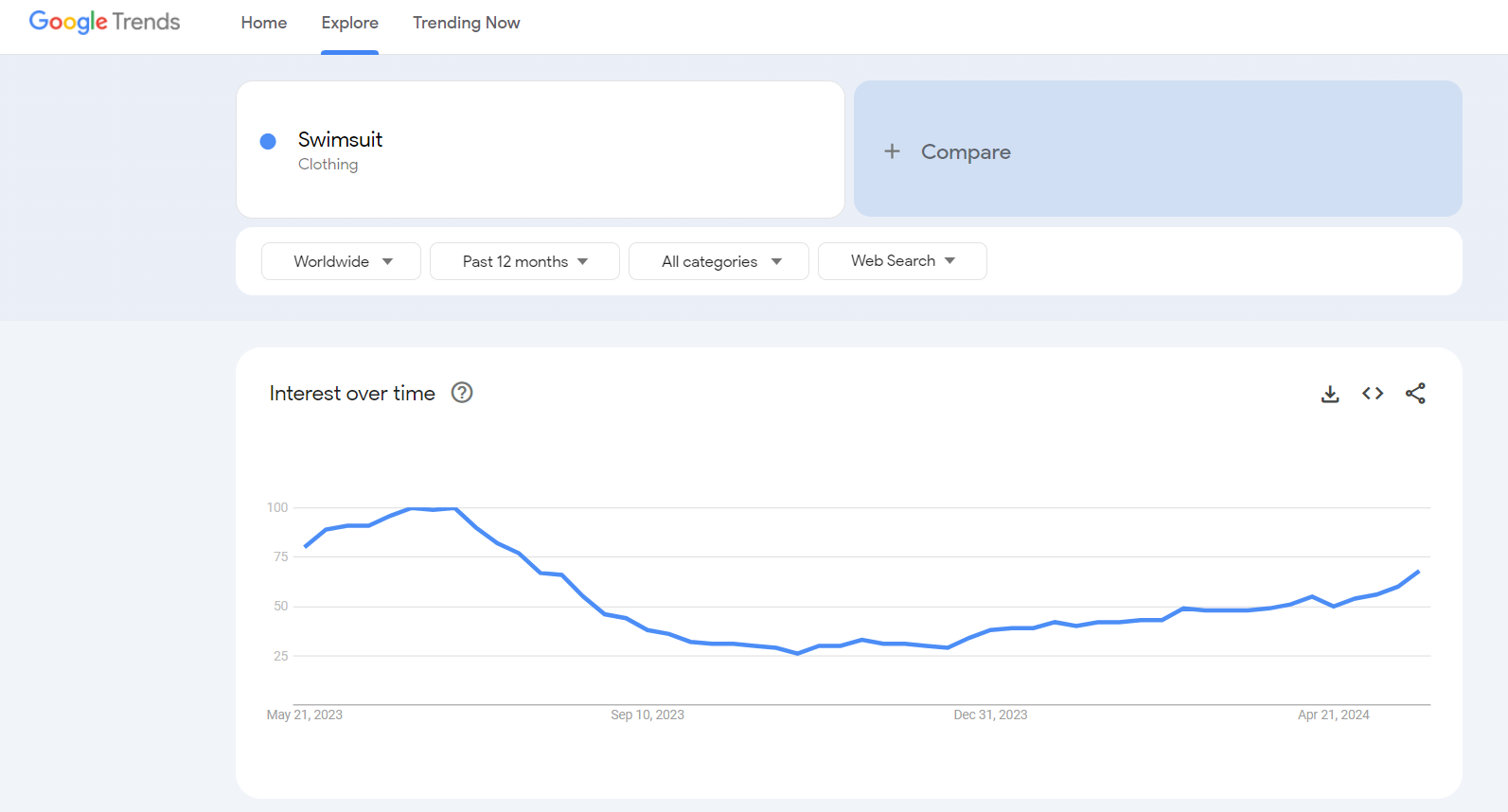
As you can see, this product demand is much higher in summer, than in autumn. With Google Trends, I get information even about interest by region, and in a certain period of time. Plus, it gives me related queries.
💡 Tip: Check out the Top 15 Hot Summer Products for Dropshipping Stores in 2024.
3. Scan the competition
Analyzing your competitors and identifying how much they charge for similar or identical products is a must for you. As a new online merchant, do not look at the largest online retailers such as AliExpress or Amazon.
Instead, focus on competitors within your specific dropshipping niche and analyze their websites and online stores. This can help you see how much they charge for similar or identical products.
If they offer the same product as you do, you should not charge more unless you provide something different and extra. For instance, you can charge more if you offer impeccable customer service and free delivery.
Also, do not try to compete on price alone. Do not continuously lower your prices to gain that one step ahead of your competition. This can be too risky and contribute to financial instability.
For this purpose, I personally love using Ali Hunter. So, I installed this AliExpress extension. And now, once I enter my competitor’s website, I immediately get any kind of valuable information about their performance, and items they sell most, etc.
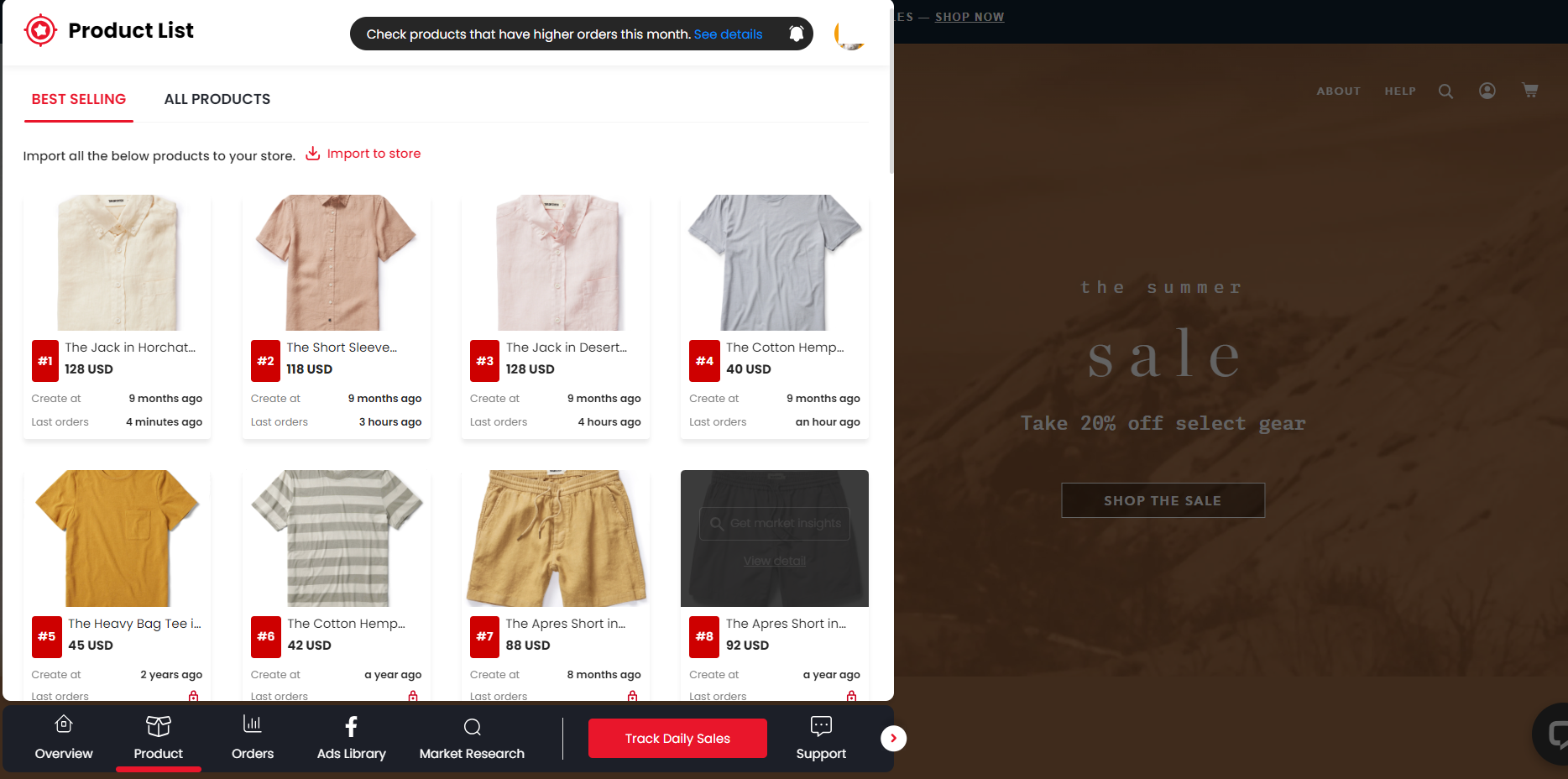
4. Learn more about your target audience
This is where things may get a bit complicated. Your dropshipping product pricing should depend on how much your customers are willing to pay for the item you sell.
In other words, if you do not know your target audience, you may end up with bad pricing and no actual customers.
Knowing who your customers are—their geographic location, age, interests, income, etc.—allows you to make the best decisions when it comes to pricing and marketing.
There are a few points that enable you to find a viable price range. In addition, this viable price range should generate sales and maintain a solid profit margin at the same time. These points are as follows:
- Consumer buying behavior
- Purchase rate (e.g., one-time, weekly, monthly, etc.)
- How much they are willing to pay
5. Determine your markup
Markup is the difference between the sales (retail) price of a product and the total cost of the product. Furthermore, the markup is typically expressed as an extra percentage that you charge your customers (on top of your cost).
Some people confuse the dropshipping profit margin with the markup. However, there is a difference between them.
Namely, the dropshipping profit margin refers to the profit as it relates to an item’s sales price or revenue generated, whereas the markup refers to the profit as it relates to the product cost.
Let’s take a look at the same example using the electronics dropshipping business and the same numbers as above to calculate the markup.
{(Sales Price – Costs) / Costs} x 100 = Markup
{($1,000,000 – $700,000) / $700,000} x 100 = 42.9%
As you can see, your dropshipping profit margin and markup are two different things. But they both are used to help determine profitability.
Once you have done all this work, it is time to decide on your dropshipping product pricing strategy.
Dropshipping Product Pricing Strategies
Prior to discussing the dropshipping product pricing strategies, it is important to know that there are three main pricing methodologies:
🔸 Cost-plus pricing
This is a simple pricing methodology. And the only thing you need to do is to calculate your total costs and add a particular profit margin to set your sales/retail price.
For instance, if the cost of materials, labor, and overhead for a particular piece of furniture is $500, and you want to achieve a profit margin of 30%, you would add 30% of $500 ($150) to the cost, resulting in a selling price of $650.
This cost-plus pricing strategy ensures that you cover all of your costs and generate the desired profit on each unit sold. It also provides transparency to customers, as they can clearly see how the price is derived and understand the value they are receiving.
🔸 Market-oriented pricing
This methodology is based on market conditions and competition. Here, you set your prices based on the prices of similar or identical items set by your competitors.
For example, an airline may use dynamic pricing to increase ticket prices during peak travel seasons when demand is high, and lower prices during off-peak periods to attract more customers.
So, by continuously monitoring market conditions and adjusting prices accordingly, businesses can maximize their revenue and profitability while remaining competitive in the market.
🔸 Consumer-oriented or value-based pricing
The consumer-oriented pricing methodology is based on the perceived or estimated value of the item you are providing to your customers.
The high-end clothing retail industry is a good example of this pricing methodology, to be more specific. Luxury fashion products are priced higher to represent their social value, rather than their functional value.
One great example of a dropshipping store that sells luxury fashion products correctly is BrandsGateway. 👇

Plus, this is more than just a dropshipping and wholesale supplier. This, it’s a dynamic B2B luxury fashion marketplace that’s transforming the way retailers and manufacturers connect.
To price your products correctly and increase your profit margins, use one or more of the following methodological approaches.
🔸 Penetration pricing
As its name suggests, this dropshipping product pricing strategy is ideal for dropshipping beginners who want to penetrate the market.
You are a dropshipping beginner, aren’t you? So, in the beginning, drop your prices below the competition to gain a foothold in the market and boost sales. After you have attracted a substantial customer base, you can GRADUALLY raise your prices.
One example of a dropshipping store that has used penetration pricing and succeeded is “DropshipDeals.” This store focuses on offering a wide range of trendy and affordable products, targeting price-sensitive customers who are looking for great deals.

By strategically pricing its products at a lower cost compared to its competitors, DropshipDeals was able to quickly attract a large customer base. They focused on building a strong online presence through social media platforms and search engine optimization, ensuring that their products were easily discoverable by potential customers.
🔸 MSRP pricing (Manufacturer’s Suggested Retail Price)
For some new dropshippers, including you, it may be difficult to set the right prices. But this is where MSRP comes into play.
It is a dropshipping product pricing strategy where you set prices recommended by your suppliers. In reality, this strategy is a good choice for you if you want to find a safe middle ground.
🔸 Bundle pricing
You have probably seen sales promotions like, “Buy two, and get 15% off” or “Buy three, get one free”. And this is the bundle pricing strategy. You can use it to drop your item’s retail price and turn a higher profit in the end.
Actually, your favorite McDonalds, or Burger King menu meals are based on bundle pricing. So, how do you feel when they give you 3-in-1 products at an affordable price? I stand in the buy line ✌️!
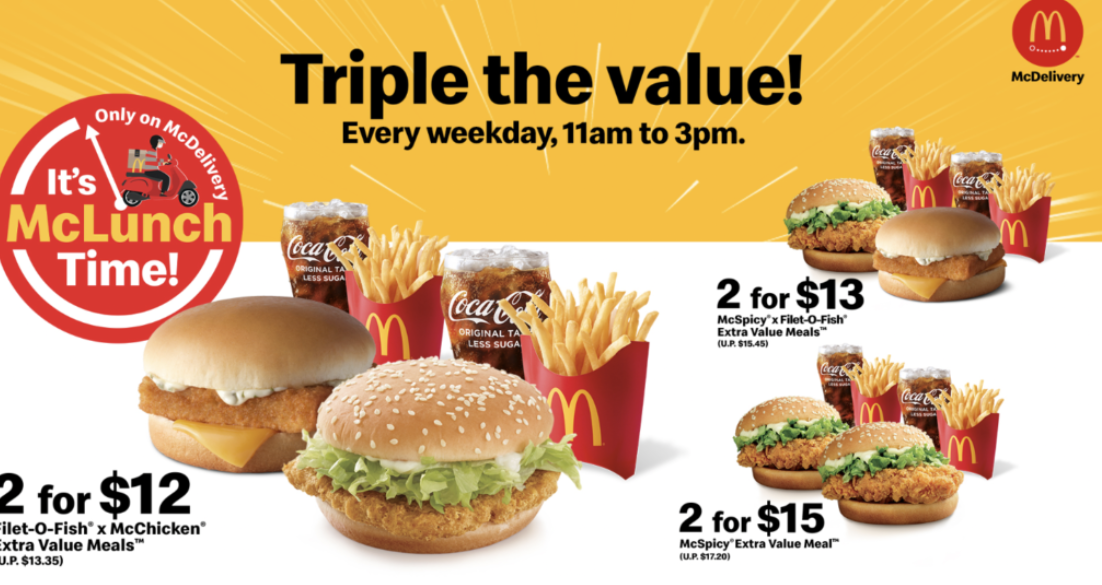
🔸 Premium pricing
Interested in dropshipping luxury clothing brands? Then, opt for this dropshipping product pricing strategy and set high prices to highlight your products’ quality and exclusivity.
🔸 Psychological pricing
This is an old method of setting pricing, as you probably know. Additionally, the idea behind this pricing strategy is that people will see the slightly lowered price and “think” it is lower than the actual price.
Even in the dropshipping industry, this strategy works well. Unsurprisingly, $99.99 does way better than $100. So, why not utilize psychology to encourage your visitors to buy something from your website?
How To Select The Most Profitable Products to Sell Online?
Well, selecting the most profitable dropshipping products is not easy. Therefore, you need to analyze several market aspects. Therefore, here I will list some of them.
1. The type of your dropshipping store
If you start researching which type of dropshipping is best at chasing high-profit margins, I am sure you will not find an exact answer. General store, a niche store, or a single product store?
While there is some disagreement about whether to start with a general store first, a niche product store, or a one-product store, most results typically support one-product stores in terms of generating high-profit margins.
This is because a one-product store has more credibility, and buyers see your store as the exclusive place to purchase that one-of-a-kind product.
On the other hand, a disadvantage of offering the items with the highest margins through a general store is that your customers may already be aware of some of the other products your general store offers.
👉 Learn about How to build a one-product store.
2. Product’s market demand
How can you predict whether the products are going to sell on the market? Well, not an easy one too, but I have a few things you should pay attention to!
First, ask yourself, Is my product solving problems for customers?
Problem solvers are the greatest high-profit items to offer online. If a person has a serious problem and sees an advertisement for a product that will help him, he will most likely purchase that product.
Furthermore, analyze the product’s potential for going viral via social media. Some dropshipping products have seized the web by storm, causing a massive demand for the product worldwide.
Moreover, product availability is also a very important aspect when analyzing market demand.
Therefore, an excellent product for dropshipping is one that is not widely available. Adopting the impulsive purchasing strategy is one of the most effective ways of selling high-profit items online.
You must entice the audience to the point where they will buy the product without doing any investigation. That is why the time of launching or testing a product in dropshipping is critical.
👉 Check out the Best Dropshipping Products In Any Niche For Max Profits.
3. Competition
The next important thing when selecting profitable products is competition.
When a dropshipper finds a winning product, the competition in dropshipping becomes tough. This is because other dropshippers continue to spy on each other.
Moreover, this is when the market for dropshipping items becomes oversaturated.
Therefore, just because dropshipping is saturated doesn’t mean you can’t make profits. Actually, this just implies that you must concentrate more on generating value, branding your company, and actually assisting your clients.
However, if there are too many competitors on a certain product, consider taking a reasonable share and exploring different goods.
👉 Find out what your competitors do by using these Top 15 Best Facebook Ad Spy Tools For Dropshipping.
4. Trends
This factor is undoubtedly one that you should not avoid. Following trends always show you the path to success, since customers do that too.
Moreover, with today’s huge impact of social media, like TikTok, or Instagram over customers, you can easily see which products are becoming a thing!
👉 Check out the 100+ TikTok Bio Ideas For Your Dropshipping Business In 2024.
Furthermore, you can always find information about Trending Products over dropshipping directories like AliExpress, or Dropshipping.com. Also, you can follow Google Trends.
👉 Learn How to Use Google Trends for Dropshipping.
Also, some high-profit margin items have a distinct trend. If the product is new, the tendency will be rising as the market begins to establish the product.
Now let’s find out some of the high-margin dropshipping products!
High Margin Dropshipping Products
As I already mentioned, not all product niches and types of products have the same profit margins. Some of them have higher than others.
In this article, I will discuss some of the dropshipping products with high-profit margins you should consider selling. Let’s begin!
Fitness Equipment
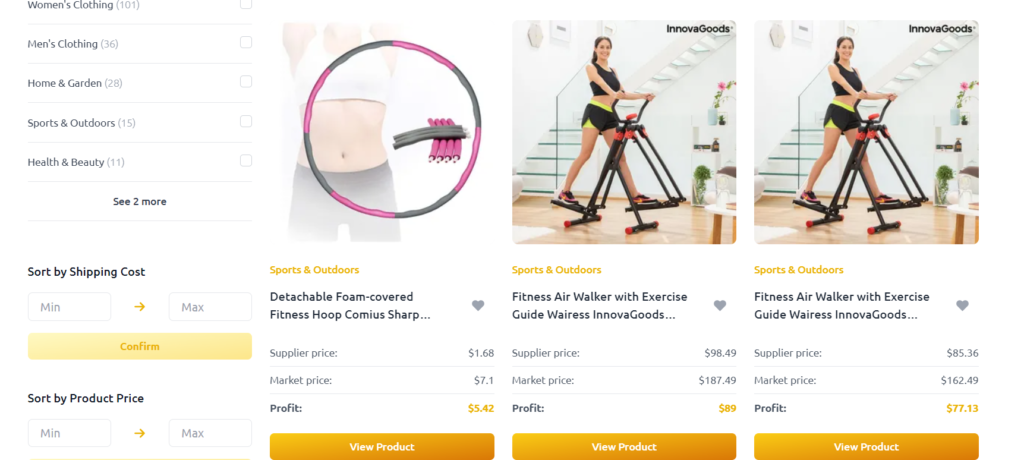
The demand for these types of products in the past two years is insane! And not just that, profit margins are also high!
For example, let’s take a look at my product directory. Most fitness products hold profit margins between 50% to 60%, and some of them are even higher.
Let’s see this product for example 👇

Its supplier price is $16.58, and the selling price is 41.45. Therefore, this leaves you with a profit margin of 60%.
💡 Tip: Read about Fitness Dropshipping: Best Fitness Dropshipping Suppliers, Top Fitness Niche Products & Store Examples.
Phone Accessories

Next to my list are phone accessories. Without a doubt, these dropshipping niche products are always on the list of top trending products. Search whenever you want, and you will get the same results.
If I take a closer look, I will see that these products have high dropshipping profit margins, around 60% to 65%.
For example, let’s take a look at this product.👇
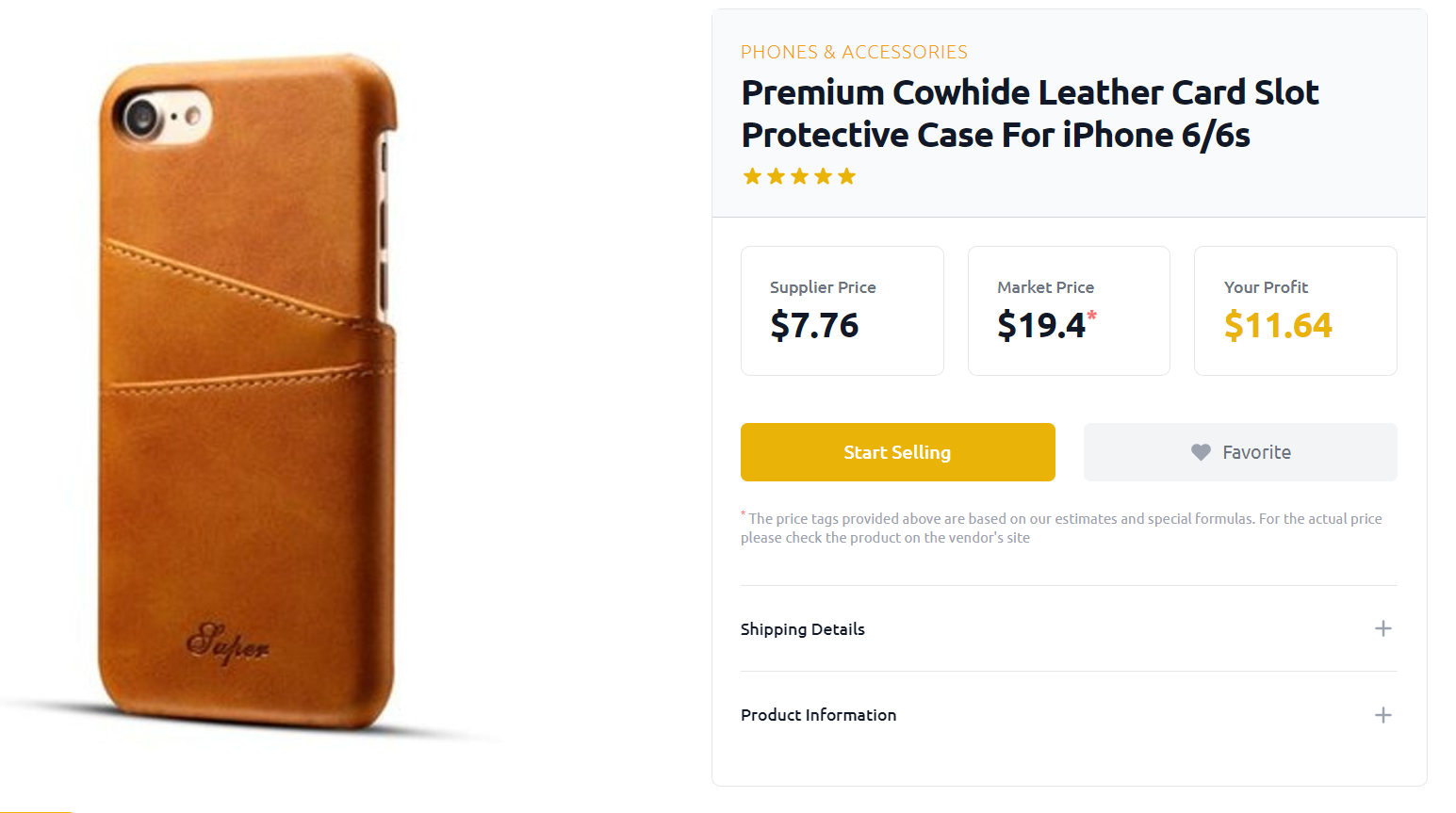
This protective phone case has a supplier price of $7.76, while its selling price is $19.4. That way you are working with a profit margin of 60%. This dropshipping profit margin is high and leads to great dropshipping profit.
Skincare & Beauty Products
Next, the skincare and beauty products! Not just women, but also men have become more aware of their skincare.
👉 Check out the Top 11 Best Health and Beauty Dropshipping Suppliers & Trending Products.
Therefore, as the demand for these products has risen, so has the customer base.
This dropshipping niche is a great opportunity if you are chasing products with high dropshipping profit margins.
For example, look at this product.👇

Its supplier price is $6.84, and the selling price is $17.1. Thus, this product’s dropshipping profit margin is 64%.
Skincare & Beauty product niche has high dropship profit margins, which are around 60% to 65%.
👉 Read my in-depth analysis of the skincare niche.
Home Decor & Home Organization
Last, but not least. Home Decor has become a thing when I talk about dropshipping.
👉 Learn How To Sell Home Decor Online: Guide, List Of Suppliers & Examples.
For you as a dropshipper, this niche is highly recommended if you want high dropshipping profit margins. But who doesn’t?
These products’ profit margins are around 40%-50%, but also there are products with higher dropship profit margins, which are around 60%.
For example, this storage box supplier’s price is $20.99, and the selling price is $52.48. Thus, the product’s profit margin is 61%. 👇
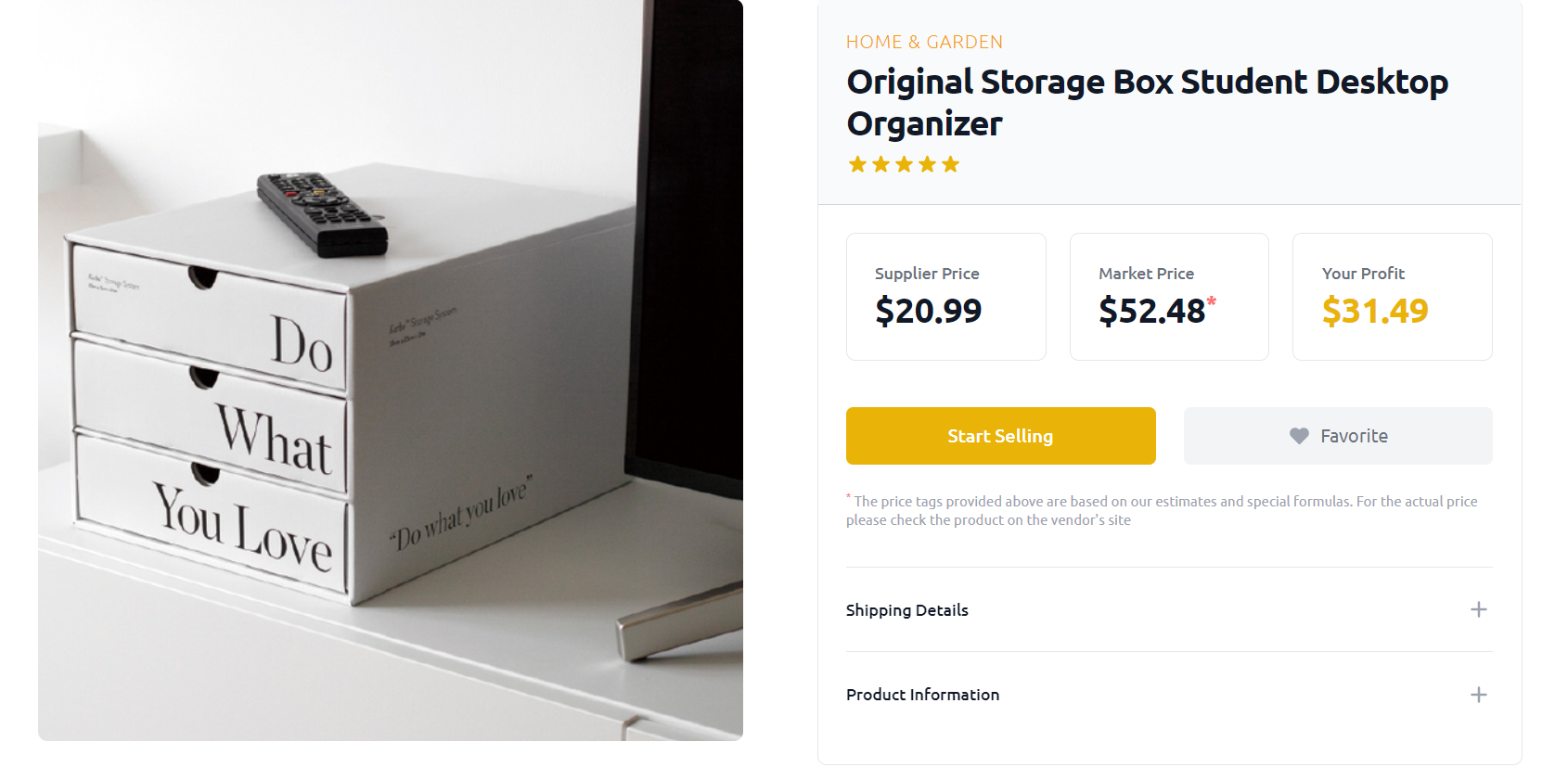
💡 Tip: If you are interested in dropshipping home decor products, take advantage of my Free Home Decor Supplier list.
👉 Also, read my full, and in-depth review of the Home Organization product niche.
How Much Does The Average Dropshipper Make?
As you start dropshipping, one of the first questions that will pop up to you is of course- How much does the average dropshipper make?
This question has no particular or obvious response. To estimate how much money you can make from the dropshipping business, you must first grasp how the dropshipping model works.
If you are working with low-ticket dropshipping, you should know that many dropshippers make even less than $500/month. However, you can always switch your strategy if you want to make more.
To increase profits, you will need to engage in huge, profitable marketing efforts. Better still, you should try with ‘high ticket’ dropshipping.
Instead, with high-ticket dropshipping, you concentrate on finding the greatest dropshipping items to offer. This model grows slowly, but it has longevity, which can lead to higher profits year after year, maybe even more than $100,000 per month.
💡 Tip: Check out the High Ticket Dropshipping: Best Product Categories To Sell.
As the average is made up of the highest and the lowest, let’s give an answer to how much does the average dropshipper make?
Dropshippers typically earn between $1000-$50,000 per month in net revenue on average, or $100-$20,000 in net profit. This often translates to a 10-40% dropshipping profit margin for each sale, with around 10-10,000 orders issued and completed each month.
👉 Check out these dropshippers’ stories: Dropshipping Profit: Expectations vs. Reality.
Calculate Shopify Gross Margin
As we already know, gross margins are calculated by subtracting the cost of goods sold (COGS) from the gross sales, then dividing the result by the gross sales, and multiplying the result by 100.
However, Shopify has several amazing apps for calculating gross margins.
First, there is the Shopify Retail Profit margin calculator, which is 100% free to use.
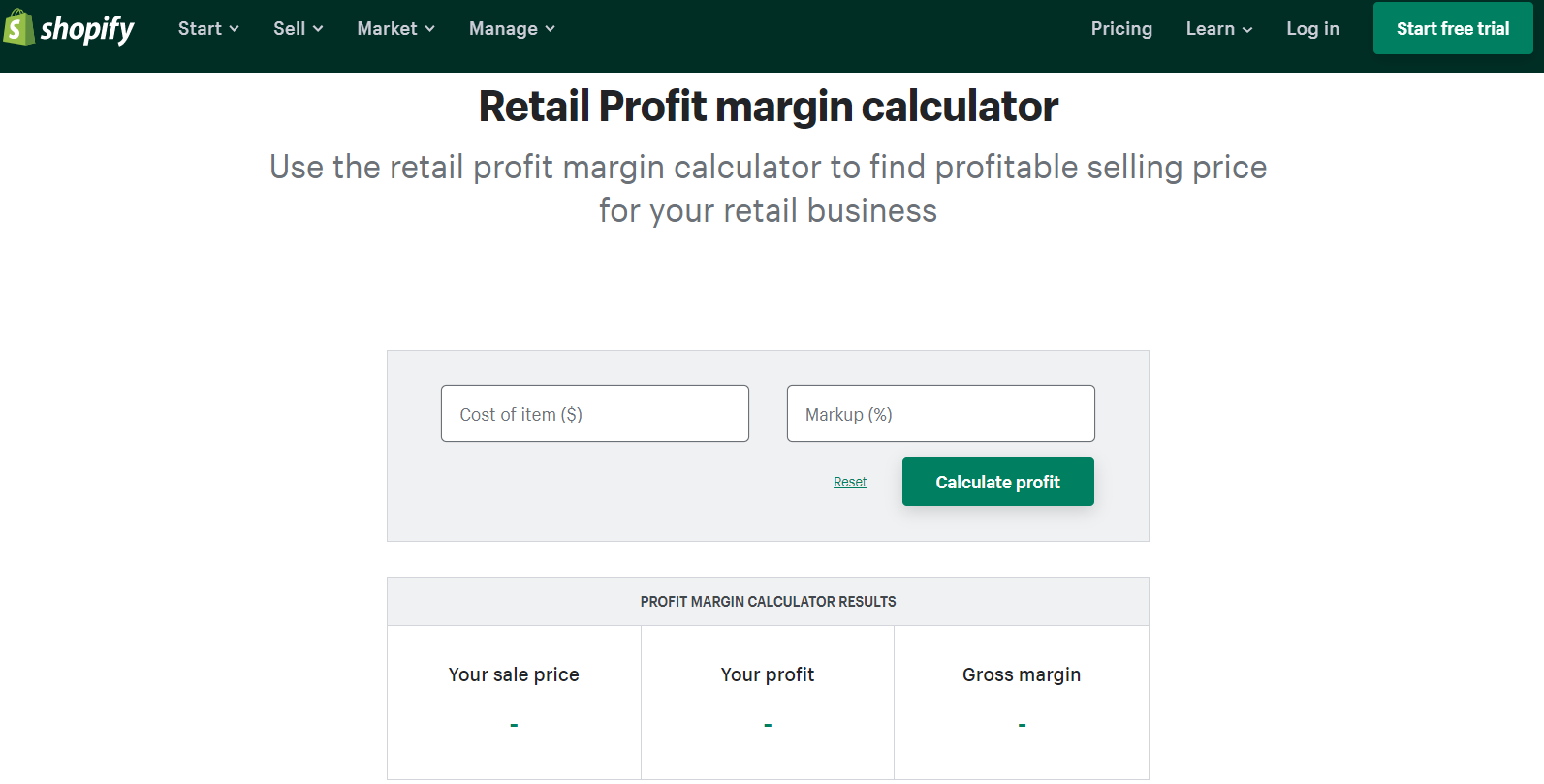
The retail profit margin calculator on Shopify will assist you in determining a competitive selling price for your items.
So, how does the Shopify gross margin work?
First, you write the gross cost of each item and the percentage of profit you want to generate on each transaction.
When you select “Calculate profit” the program will run those figures through its profit margin algorithm to determine the final amount you should charge your consumers.
Moreover, there are other Shopify gross margin apps, like:
- BeProfit– Free, up to $150/month
- SimplyCost – $4.99/month
- Webgility Pro – $49/month
- Lifetimely – $19-$99/month
- Accountify – Free
- Profitario – Free, up to $39.90/month
- Conversific ‑ Free, up to $199/month
FAQs – Dropshipping Profit Margins
1. What is a good profit margin on dropshipping?
A good profit margin on dropshipping can vary depending on several factors. However, as a general guideline, a profit margin of around 15% to 30% is considered good in the dropshipping industry. It allows room for covering expenses such as advertising, shipping, and customer acquisition costs while still generating a healthy profit.
2. How much profit can you make from dropshipping?
The amount of profit you can make from dropshipping largely depends on the product price, market demand, and your marketing efforts. While it is difficult to pinpoint an exact figure, successful dropshippers can make anywhere from a few hundred to several thousand dollars in profit each month.
3. Is a 6% profit margin good?
A: A 6% profit margin may not be considered ideal in the dropshipping world. With such a low margin, it becomes challenging to cover expenses and generate significant profits. It is important to aim for higher profit margins to ensure a sustainable and profitable dropshipping business.
4. Is 30% profit margin too high?
Having a 30% profit margin in dropshipping is not necessarily too high. It can be a good target for many dropshippers as it allows for a decent profit while still being competitive in the market. However, it is crucial to consider other factors such as the cost of advertising, shipping, and any other expenses associated with running a dropshipping business.
5. Is 13% profit margin good?
A 13% profit margin may be considered on the lower side in the dropshipping industry. While it is important to consider your specific circumstances, aiming for a higher profit margin can provide more breathing room to reinvest in your business, cover costs, and generate consistent profits.
6. Is a 50% profit margin too much?
A 50% profit margin can be significantly high in the dropshipping industry. While it may seem lucrative, it is important to consider market demand, competition, and product pricing. It is essential to strike a balance between generating profits and offering competitive prices to attract customers.
7. What profit margin is good with Shopify?
The profit margin varies with the type of dropshipping business and the products you choose to sell. However, aiming for a profit margin of around 20% to 30% with Shopify is a common goal. This range allows for covering expenses and generating profits while utilizing the features and benefits of the Shopify platform.
8. What is a good dropshipping profit margin in 2024?
When it comes to dropshipping, profits usually fall in the range of 10% to 30%, but keep in mind that these numbers aren’t set in stone.
To figure out the sweet spot for your business, take the time to dive into market research, carefully assess your costs, and stay in the loop with the latest industry trends. This way, you’ll be better equipped to make thoughtful decisions about pricing and profit margins in 2024.


Your Dropshipping Profit Margin matters
As discussed above, pricing your dropshipping products is a complex process. Plus, it plays an important role in your business’s financial health and profitability.
But I walked you through the process to help you calculate your dropshipping profit margin, choose the best dropshipping product pricing strategy and set the right prices for your products.
Get our expert advice for everyone starting his first Dropshipping Business.













![The Top 21 3PL Companies Compared [2024 List & Guide]](https://images.weserv.nl/?url=https://prod-dropshipping-s3.s3.fr-par.scw.cloud/2024/03/Frame-3922469.jpg&w=420&q=90&output=webp)